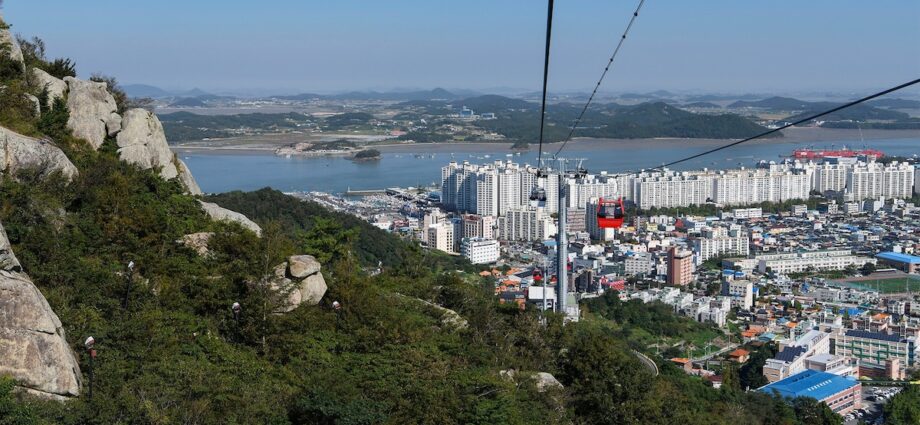This article was produced by National Geographic Traveller (UK).
Most visitors to South Korea land on one of two islands: Yeongjongdo, home to the giant Incheon International Airport, or Jeju, the country’s largest — a major draw in the South Sea for its volcanoes and pristine beaches. They often leave unaware that the peninsula is surrounded by a spray of more than 3,000 other isles — some inhabited, some mere bluffs of rock that appear and vanish with the tides. The greatest concentration is found around the southwestern city of Mokpo, which, thanks to increased government funding in recent decades, has morphed from little more than a provincial backwater to a destination with its own salty charm.
It’s possible to admire the islands near Mokpo without leaving the mainland. There are viewing points around Yudalsan, a small mountain within easy walking distance of the train station. It’s also the starting point for the Mokpo Marine Cable Car, which stretches two miles across the water to small Gohado island. Here, visit the Gohado Observatory for some of the best views. Once back in Mokpo, consider a visit to the National Research Museum of Maritime Heritage, too. It focuses on local seas, but its prime draws are the relics found in two wrecks sunk here in the 11th and 14th centuries, including willow-green bowls.
The islands closest to Mokpo are some of the most pristine in the area. The best is little Oedaldo, an hour from the city by ferry, where you’ll find sandy Oedaldo Beach and Oedaldo Hanok Village. This island receives so little in the way of visitors that the few businesses operating here — simple guesthouses, plus the odd restaurant and shop — are generally unstaffed. They’ll have phone numbers in the windows, though the owners won’t necessarily be anywhere nearby. It’s a world away from the convenience of Seoul, or indeed any Korean city, and can come as a refreshing change.
Further west lies the archipelago of Sinan County, which has 111 inhabited islands — some protected as part of Dadohaehaesang National Park and almost all accessible by ferry or road from Mokpo. Life trundles by at a sedate pace in these parts; fishing is still the main earner, a fact made evident each night by the lights of distant squid boats, shining like fallen stars on the horizon.
In recent years, many Sinan islands have been connected to the mainland’s road network via a series of bridges. One area has become especially popular: Purple Island, which, despite the name, is actually made up of two islets — Banwoldo and Bakjido — connected by footbridges to larger Anjwado, accessible by bus from Mokpo in around three hours. The bridges are purple, as is almost everything that you’ll see here: roofs, cafes like Purple Island Cafe and even flowers.
The best-loved islands, however, are the most distant. More than 60 miles west of the mainland and almost two hours away by ferry, Heuksando is its own miniature archipelago. Its forested islands provide fantastic hiking terrain, but most visitors tour the coastline on boat tours from Yeri, the main port. Heuksando is also famed for its fermented skate, hongeo — though, if you’re not accustomed to the taste, you’re more likely to enjoy the non-fermented variety, served like sashimi. Another 15 miles west is Hongdo (‘Red Island’), named after the pigmentation of its cliffs. It rises dramatically to almost 1,300ft, with its main village sprawling across a saddle-like rise.
On both Heuksando and Hongdo, mainland South Korea feels far away in more ways than one. Once the last ferry has headed off, you’re marooned for the night — or sometimes even longer, should poor weather force the cancellation of the ferry services. But, in among these emerald isles and their oceanic peaks, there are far worse places to be.
Published in the South Korea guide, distributed with the November 2024 issue of National Geographic Traveller (UK).
To subscribe to National Geographic Traveller (UK) magazine click here. (Available in select countries only).

